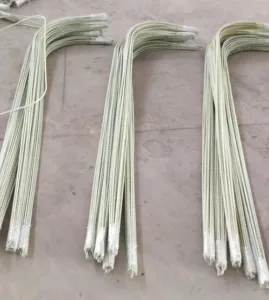Gator Bar fiberglass rebar is an excellent alternative to traditional steel reinforcement in construction projects. It offers several advantages such as corrosion resistance, lightweight design, and high tensile strength. If you’re planning to use Gator Bar fiberglass rebar for your project, it’s essential to know the proper installation process. In this article, Unicomposite pultruded profiles will guide you through five easy steps to install Gator Bar fiberglass rebar effectively.

gator bar fiberglass rebar
Step 1: Prepare the Work Area
Before installing Gator Bar fiberglass rebar, it is crucial to prepare the work area properly. Here’s what you need to do:
- Clear the construction site of any debris, rocks, or vegetation that may hinder the installation process.
- Ensure that the ground is compacted and leveled to provide a stable base for the rebar.
- Determine the layout and dimensions of the rebar, taking into account the project requirements and design specifications.
Step 2: Cut and Position the Gator Bar Fiberglass Rebar
Once the work area is prepared, it’s time to cut and position the Gator Bar fiberglass rebar. Follow these steps:
- Measure and mark the required length of the rebar using a measuring tape and marker.
- Use a cutting tool specifically designed for fiberglass rebar to make clean and precise cuts.
- Position the cut rebar in the predetermined locations, ensuring proper alignment and spacing as per the project requirements.
Step 3: Secure the Rebar in Place
To ensure the stability and integrity of the structure, you need to secure the Gator Bar fiberglass rebar in place. Here’s what you should do:
- Use rebar chairs, supports, or tie wire to hold the rebar in position, keeping it elevated from the ground or formwork.
- Make sure the rebar is securely fastened to the ground or formwork, preventing movement during the concrete pouring process.
- Double-check the alignment and positioning of the rebar before proceeding to the next step.
Step 4: Space and Connect the Rebar
Proper spacing and connection of the Gator Bar fiberglass rebar are essential for reinforcing the concrete effectively. Follow these guidelines:
- Refer to the project specifications or engineering drawings to determine the required spacing between the rebar.
- Use rebar spacers or chairs to maintain the desired spacing between the rebar layers.
- Overlap the rebar sections according to the project requirements, ensuring proper connection and continuity.
Step 5: Pour Concrete and Finish the Installation
After the rebar is correctly positioned and connected, it’s time to pour the concrete and complete the installation process. Follow these final steps:
- Prepare the concrete mix according to the project specifications, ensuring the right consistency and strength.
- Pour the concrete evenly, making sure it completely surrounds and encases the Gator Bar fiberglass rebar.
- Use a vibrating tool to eliminate air pockets and ensure proper compaction of the concrete.
- Finish the surface of the concrete as desired, using trowels or other appropriate tools.
- Allow the concrete to cure and harden according to the recommended timeframes before proceeding with further construction.
Conclusion
Installing Gator Bar fiberglass rebar in your construction project can bring numerous benefits, including improved durability and longevity. By following the five easy steps outlined in this article, you can ensure a successful installation process. Remember to prepare the work area, cut and position the rebar accurately, secure it in place, space and connect the rebar appropriately, and finally, pour the concrete and finish the installation. By doing so, you’ll enhance the structural integrity of your project while harnessing the advantages offered by Gator Bar fiberglass rebar.
FAQs
Q1: Is Gator Bar fiberglass rebar suitable for all types of construction projects?
Gator Bar fiberglass rebar is versatile and suitable for various construction projects, including concrete foundations, walls, and slabs. However, it’s essential to consult with a structural engineer or follow the project specifications to determine its suitability for your specific application.
Q2: Does Gator Bar fiberglass rebar require any special tools for installation?
Yes, to cut Gator Bar fiberglass rebar accurately, you will need a cutting tool specifically designed for this purpose. These tools ensure clean cuts without damaging the rebar’s integrity.
Q3: Can Gator Bar fiberglass rebar be used in corrosive environments?
Yes, one of the significant advantages of Gator Bar fiberglass rebar is its excellent corrosion resistance. It is an ideal choice for construction projects located in corrosive environments such as coastal areas or structures exposed to chemicals.
Q4: Does Gator Bar fiberglass rebar require any maintenance after installation?
No, Gator Bar fiberglass rebar is virtually maintenance-free. Unlike steel reinforcement, it does not corrode or rust, eliminating the need for ongoing maintenance and inspections.
Q5: Where can I purchase Gator Bar fiberglass rebar?
To purchase Gator Bar fiberglass rebar, you can visit the official website of the manufacturer or contact authorized distributors and suppliers in your region. They will provide you with the necessary information and assistance regarding availability and pricing.
 info@unicomposite.com
info@unicomposite.com


























